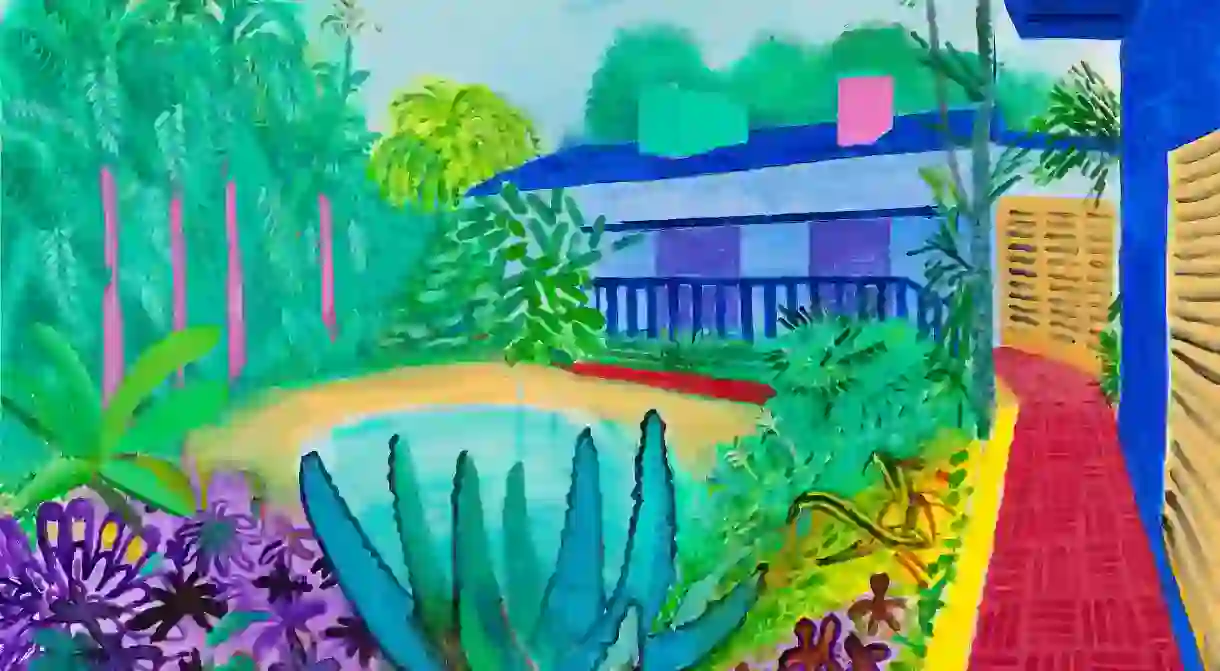If You Do One Thing in 2017 Make Sure You See David Hockney at Tate Britain

Step into the wondrously colourful world of David Hockney at Tate Britain’s magnificent retrospective. Electric, dynamic and experimental, it’s the one mega blockbuster that everyone needs to see in 2017.
He may have swapped the dreary grey shores of the UK for the sunnier climbs of California, but David Hockney is still regarded as one of Britain’s most popular and influential artists. And if the foray over what is the fastest-selling exhibition in Tate’s history is anything to go by, then Hockney won’t be relinquishing that title anytime soon.

As the artist approaches his 80th birthday, now more than ever feels like the right time to look back at his expansive career.
‘It has been a pleasure to revisit works I made decades ago, including some of my earliest paintings. Many of them seem like old friends to me now,’ said Hockney.
‘We’re looking back over a lifetime with this exhibition, and I hope, like me, people will enjoy seeing how the roots of my new and recent work can be seen in developments over the years.’

So what can you expect from a show that includes more than 120 works?
There are the swimming pools, including Hockney’s now iconic A Bigger Splash, the glitterati of Hollywood and bohemian London, intimate depictions of family and close friends, rolling Yorkshire countryside and vibrant vistas of Hockney’s Californian garden.


Presented as a chronological overview of Hockney’s prolific oeuvre that encompasses many mediums from paintings, drawings and prints to photography, video and digital iPad creations, the exhibition takes you on a journey of artistic discovery.
Early and often rarely seen works from his days at the Royal College of Art in the 60s set the foundations. Here, he challenges style and subject matter and paintings become more an expression of Hockney’s sexuality. In his Love series, dark, sinister abstract grounds which are populated with scrawled figures explore the real and imagined relationships between men, at a time when homosexuality was illegal in the UK.

So it wasn’t long before the allure of the sunshine state would take hold. Hockney continued to experiment with abstraction and representation, but there was a distinctive shift in his approach from the time he started to spend more time in Los Angeles.
His colour palette exploded as he depicted the verdant open spaces and modernist buildings of the Californian city.


At the end of the 1960s, Hockney shifted his attention again and began to concentrate on the naturalistic representation of the figure. On enormous canvases, staged compositions of couples – all close friends – he explored the complexities of human relationships as well as reimagined the scope of portraiture and the possibilities of acrylic paint.


As you move between the 12 galleries, which have all been cleverly painted in five specially selected shades of Designer Guild paint that brilliantly complement and enhance the work, Hockney’s openness for experimentation is paramount. His Polaroid composites of the 1980s enabled him to capture multiples aspects of one scene, giving him and the viewer various viewpoints. They echo cubism and create a unique pictorial effect that would go on to influence his later paintings.



Throughout the show, two subjects reign supreme, that of Yorkshire and California.
For a brief time, Hockney returned to his home county and created a series of works that represent locations of importance to him. He also began to tease out the potential of technology, and the show includes numerous iPad drawings as well as an immersive video installation that captures the same stretch of Yorkshire road throughout the changing seasons from multiple video angles.


With the inclusion of two freshly finished paintings made specifically for the exhibition, Hockney’s prolific, vivacious and downright joyous output is a wondrous experience. He is celebratory yet inquisitive, considered yet exuberant. Whether you yearn for the rural idyll or the exchange of laughs during a card game, Hockney has been there and captured that moment in time for the rest of history and us to enjoy.




David Hockney‘s retrospective is at Tate Britain, Millbank, Westminster, London SW1P 4RG from February 9 to May 29, 2017.













